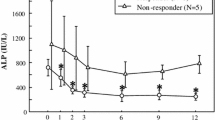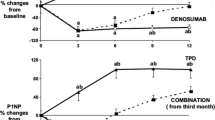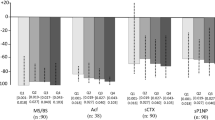Abstract.
The objective of this study was to analyze the effect of surgical menopause and Paget's disease of bone, as well as the influence of therapy, on the isomerization of the carboxyterminal telopeptide of type I collagen (CTX). Fourteen women who had undergone surgical menopause and had begun hormone replacement therapy (HRT) after surgery were recruited. Results for these women were compared with those of 29 patients with Paget's disease of bone treated with tiludronate (400 mg/day) for 3 months, and with those of a group of 21 healthy premenopausal women (control group I). In addition, 14 healthy individuals with an age range similar to that of the pagetic patients (control group II) were included in the study. Urine samples were analyzed for levels of nonisomerized and β-isomerized CTX (α-CTX and β-CTX). Biochemical determinations were performed 3 months after surgical menopause and after 3 and 9 months of HRT, and at baseline, and 1 and 6 months after tiludronate treatment in the pagetic patients. The average levels of α-CTX and β-CTX were higher in patients than in controls. In patients after surgical menopause, because of their greater increase of β-CTX, the α-CTX/β-CTX ratio was lower than that of control group I (0.881 ± 0.3 vs 1.515 ± 0.8; P < 0.05). In contrast, at baseline, pagetic patients showed marked increases in α-CTX levels, resulting in a higher α-CTX/β-CTX ratio than that of control group II (2.879 ± 1.3 vs 0.96 ± 0.25; P < 0.0001). The average percent decrease in both markers after therapy was similar in both conditions (−60% for α-CTX and −44% for β-CTX after 3 months of HRT in the surgical menopause group, vs −66% for α-CTX and −41% for β-CTX in the pagetic group, 1 month after finishing tiludronate therapy; P, NS), resulting in a significant decrease of the α-CTX/β-CTX ratio in pagetic patients (2.879 ± 1.3 vs 1.614 ± 0.8; P < 0.001). In conclusion, surgical menopause is associated with a decrease in the urinary α-CTX/β-CTX ratio because of the higher increase in the β-CTX level after menopause. Pagetic patients show an increase in this ratio, compared with the control value, and the ratio decreases after bisphosphonate treatment. The response to therapy was similar in both conditions, with a comparable decrease of both markers. These findings show how bone markers may contribute to the understanding of pathophysiologic mechanisms in bone diseases.
Similar content being viewed by others
Author information
Authors and Affiliations
Additional information
Received: July 16, 2001 / Accepted: November 9, 2001
About this article
Cite this article
Peris, P., Alvarez, L., Monegal, A. et al. Effect of surgical menopause and Paget's disease of bone on the isomerization of type I collagen carboxyterminal telopeptide: evolution after antiresorptive therapy. J Bone Miner Metab 20, 116–120 (2002). https://doi.org/10.1007/s007740200016
Issue Date:
DOI: https://doi.org/10.1007/s007740200016




